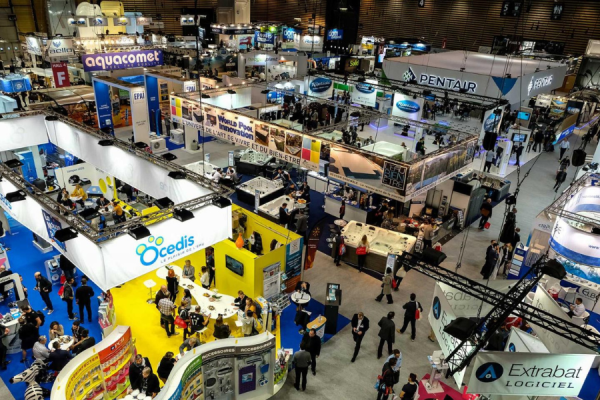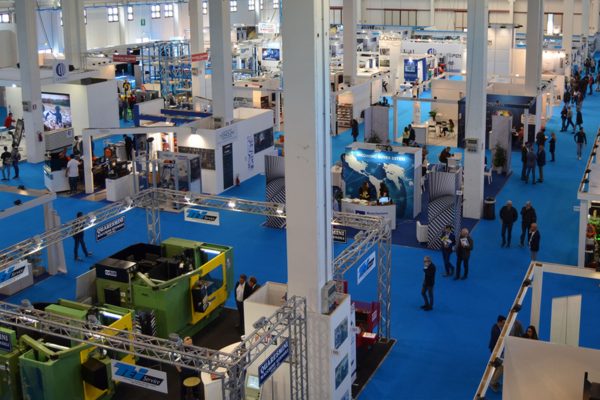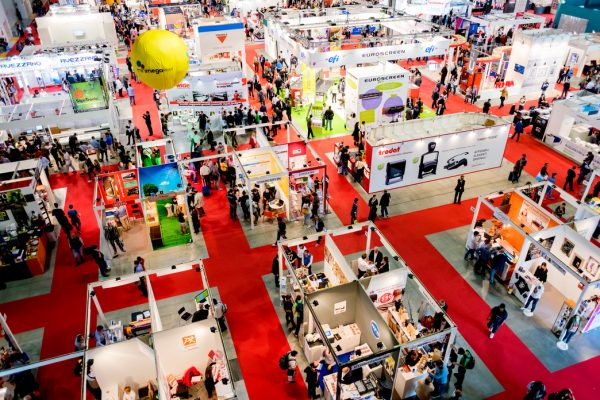The complete guide to organizing an exhibition: from registration to the D-Day

Outline
- Introduction
- The importance of exhibitions and trade shows
- Things you must pay heed to while planning your exhibition
- Get your bases cleared
- Organization tips for a smoothly-running exhibition
- The registration process
- The best strategy to market your exhibition booths
- D-Day dos and don'ts
- Conclusion
1 . Introduction
Exhibitions and trade shows are much more than a creative marketing hub. Digitally boosted and with various rentals and specialized services at their disposal, these have emerged as pivotal events in the business world, around which the year is planned and marketing and sales strategies revised and adjusted. Long gone are the days when trade shows were thought of as entirely formal events which would only elicit the interest of a select few in the industry.
Nowadays, such congregations are among the hottest events which can evoke major FOMO, attracting not only loyal customers and and business analysts, but also local crowds that are always seeking something a little extra and different from usual weekend hangouts.
What’s more, with how expansive the scope of exhibitions can be, it has become easier to tap into various interest groups, not solely by relying on the brand value of exhibitors but by incorporating several types of vendors, food stalls, fun activities, and inviting famous personalities as guests. It is safe to say that despite being business-oriented, exhibitions run on an edutainment principle, serving on a silver platter a cake layered with profit, visibility, engagement and information exchange that one absolutely cannot resist taking a bite out of!
Now, if you are planning to organize an exhibition or trade show of your own, be ready for an ardous, albeit fruitful journey that will test and broaden your capabilities. We have prepared here an exhaustive guide to help you be aware of the numerous facets of exhibition planning, the questions you must seek answers to before getting on with the project, and the best tips and tricks to guarantee that your exhibition is both keeping with the trends and leaving an impact.
2. The importance of exhibitions and trade shows
It is indubitable that organization at such massive scale as required for a successful exhibition demands substantial effort and energy. What justifies this investment? What is the attraction that trade shows and exhibitions hold to exhibitors and visitors alike? Are there benefits to be accrued from securing maximum participation? Here are the chief reasons why exhibitions are all the rage and why participation in trade shows is actively sought by businesses:
- Industry-specific exhibitions are the perfect place to bring exhibitors in the vicinity of a highly receptive audience in a semi-formal setup. Infinitely better than cold calling, they offer an amazing platform to advertise your message and curate a consumer experience that will go a long way in determining your broader business strategy. Generating valuable leads is the essence of participation in these events as trade show marketing offers a conducive environment and reasons for interaction without distraction.
- From an organizer’s point of view, an exhibition lands those involved the golden opportunity to establish themselves more visibly and tangibly in the industry concerned. The wonders of networking are no secret, and the proximity of exhibitors whose interests align or overlap provides a competitive boost and opens doors for collaborative ventures that may even outlast the exhibition.
- Trade shows have emerged out of the shadow cast by desperate sales tactics and annoying, clickbait promotions. Today, with a range of artistic and cultural performances, keynote speeches and discussion panels, multimedia exhibits and celebrity presence, they are at the frontline of industry and workplace glamour. The stage is set for emerging influencers, entrepreneurs, scholars, along with various established brands, to come together and foster lasting ties and impressions.
- Intimate marketing, albeit in a professional ambiance, is another reason why exhibitions attract brands keen on building and enhancing their image by proactively placing themselves in the vicinity of their likely customers. It is an exercise in shaping trust, exploring the problem areas of your target interest groups and implementing a valuable feedback system for upcoming products and services. Face-to-face interactions and product testing create invaluable opportunities to leave an enduring impression and induce customer loyalty, with people even serving as informal spokespersons of your brand.
- The visitors to a trade show, specifically those keen on approaching different booths, have been noted to have a decent, if not high, purchasing power. Return on investment is a key element in determining the success of the show for both the organizers and the vendors alike. Since a vast majority of these attendees are not going in blind and have an idea of what to expect, they are more open to pouring in their time and money into the experience.
3. Things you must pay heed to while planning your exhibition
Before you step on the field, there are numerous things to consider when sketching out a plan of action. It is important to head into exhibition planning without thinking of it as a one-time event that, once finished, will be lost to the throes of regular work days and overrun social calendars. There is much to be done after to secure the payoff from the efforts you put in before and during the exhibition.
Plan ahead:
Organizations of this scale, especially exhibitions that involve the coordination of myriad parties at each level, are not to be rushed. Brainstorming must begin several months before the event, if not earlier, and should take into consideration a general trajectory of other major exhibitions and conferences specific to the field that are supposed to take place down the line, the location and weather conditions around the tentative dates of your exhibition and its accessibility. Travel and booking logistics must consider off seasons and should be done well in advance to secure better prices. It is best to work with defined goals for sales and marketing objectives to be able to select the right medium and estimate of cost and duration.
Research your prospective sponsors and vendors:
You do not have to do everything on your own, and this includes the major spending that an exhibition requires. Search through potential investors after an interest check, locate the sponsors of earlier exhibitions in the industry concerned and create a promotional package exclusively to be sent to secure the same. Besides, while exhibition marketing should ideally suffice to draw the attention of participants renting out your exhibition booths, there is no harm in picking out a few promising businesses as exhibitors and even vendors for food and drinks’ stalls, games, etc. whom you can specially invite.
See the bigger picture:
Whether you choose to wrap up your exhibition in a day or span it across the weekend, every decision, right from budgeting and resourcing to marketing must be made bearing in mind the longevity of your ability to organize such events and long-term benefits. Good exhibition planning is not a crash-and-burn type of exercise. You weigh the material and intangible investment against the results- monetary return, industry exposure and presence, productive and enduring business relationships. Other than that, even the basic design and catering choices must also consider how many items are recyclable and portable, and whether renting or buying will be more beneficial in the long run.
4. Get your bases cleared for organizing an exhibition
Budgeting:
A close assessment of prior exhibitions in the field and the possibilities of return will help estimate how much investment should be made into the venture. Exhibition planning precedes budgeting in terms of finalizing the agenda, interest check and locating avenues of profit and succeeds the same as will be noted in the steps that follow. They main expenditures will obviously pertain to the renting of venue, custom decorations and layout, exhibition advertising and promotional events, guest appearances, employees’ salary bonuses and accommodation, commute and meals. It is always advisable to not be stretched to the maximum and leave some amount for unforseen circumstances. Also, make ample use of sponsors and even volunteers to get the work done, rewarding them adequately in the form of visibility and filler events.
Location and layout:
The choice of venue can be the wildcard of your exhibition’s success, which is why many locations offer a combination of indoor and outdoor settings to accommodate the expanding needs of grand shows. Since exhibitions and trade shows are almost entirely a thing of metropolitan cities, it is safe to choose a location that is not in the heart of a city or in a busy market or business sector in order to avoid traffic, yet not too far in the outskirts so as to be a hassle for repeated commute. Take note of the important landmarks, bus and subway routes to the venue for use in advertising. Coordinate with the venue staff on the layout and understand the floorplan properly to section the available space into booths, stage and other counters. This will also direct booth pricing. Tasteful infrastructure and minimalist décor may help cut down your design and modification costs. However, a more immersive theme selection will obviously demand a suitable canvas, which is why preliminary brainstorming for the same must be done before finalizing the venue.

Thematic framework:
It is almost certainly a given that each one of your exhibitors will have extensive plans to design their allotted trade show booths. However, that still leaves out key areas such as the entrances, passageways and the stage, notwithstanding the numerous interstices between the booths that will make up the general backdrop. So while it is not necessary to spend too much on decorations, a thematic unification is an indispensable part of presentation and creating an ambiance suited to the event. If you do not wish to spend much time on it, you can be done with this aspect by simply selecting a colour palette, keeping in mind the major brand colours of the participating exhibitors. Further, depending on the leeway your budget provides, you can opt for floral adornments, printed balloons in the prescribed colour code for the event or even splurge on a more immersive aesthetic such as winter wonderland or classic crystal decor. Don’t forget to convey your thematic decisions to the exhibitors, preferably incorporating the colour codes and visuals in the exhibitors’ kit.
Catering:
While not mandatory, food and drinks are certainly part of the experience. So after taking an account of which exhibitors and vendors are offering the same, you may hire additional catering if the ticket sales are substantially higher. Compulsory meals may also be included in the ticket pricing to be served at specific intervals when no on-stage activities are going on. In this case, don’t forget to separate vegetarian and non-vegetarian options. Allocate separate bars for alcoholic and non-alcoholic drinks, if possible.

Admission tickets:
Entertainment and interludes:

5. Organization tips for a smoothly-running exhibition
The exhibition organizer is like an invisible hand that pulls the strings, nurtures and directs, largely from behind the curtains. Your effective functioning is the skeletal structure upon which the brilliant façade rests, enabling exhibitors’ optimum performance and a fun, memorable experience for the attendees.
While there is no reason to not let exhibitors have free reign over their exhibition stands, it always helps to function with some basic thematic guidelines to streamline the process and tighten your grasp on the aesthetic cohesion of the event. Though the layout of the venue and the space allotted to each booth weigh in as primary factors in design, coming up with a colour palette and a basic texture will aid creating the desired vibe along with the participants.
Schedule pre-show booth meetings with event partners and vendors, bearing in mind a practical and roughly tangible set of targets- including attendees, leads, buyers, social media impact, etc. Additionally, survey the exhibition stand designs and activities to be able to fill in the gaps and lulls in the event with activities of your own, wherever necessary.
Utilize cloud-based marketing and management tools and apps such as GIVME to iron out communication and cooperation kinks among the different teams and parties involved.
Train your staff especially for the event. Do not rely exclusively on their pre-existing capabilities and roles of responsibility executed in a different, more private setup. Effective communication between the different teams, such as sales, executive and marketing, is a must. Use spreadsheets and Google Calendar for better coordination, complete with the roles and contact details of the team members for instant access. Make printed copies available at several junctures, and be prepared with a comprehensive information compilation in the form of a slide deck or a handbook to ensure that every member is made aware of the exhibition events outline and hours, vendors, venue and other booking details (such as hotels, parking, transport), theme and dress code.

Erect labelled (or better still, scannable) maps at the venue at the entrances and other turns and corners, where they can be easily spotted.
Work together with vendors offering food and beverages to ensure a steady supply of drinking water. They may also be asked to come up with meals at subsidized rates to be clubbed with yet another category of admission tickets, or you can collaborate with them on various activities and contests so that the attendees may cash their coupons at these stalls, be offered complementary mocktails or ice cream scoops in the desired flavour.
Safety concerns at a massive event are obvious, and must be at the forefront of your mind and not be left solely in the hands of the venue staff. If the crowd is particularly massive, peaking during the time of a celebrity in attendance, appropriate space and multiple pathways should be cleared to accommodate the influx. The area should be properly ventilated, well-lit, and in case of soaring temperatures, provisions for cooling may be made. Appoint a first-aid team and contact ambulance and fire-brigade services.
Use a badge scanner to take better charge of the show by effectively managing booths, attendees and leads. Badge scanner apps can be personalized to meet your cost requirements and allow for importing both pre-show and on-site data to streamline forwarding of the necessary information to your exhibitors after the event- a valuable asset in retaining customer loyalty and proving the benefit of participation. This will be an immense help in planning future events. They also offer live reporting functions to help gather valuable intelligence in assessing performance, and some even have note-taking options to be attached to leads.
Organize a prep call at least a week before the day of the exhibition to test the functionality of your plan, as well as more practical details such as the availability of power, booth schedules and crowd management. Make time to address possible situations of crises such as power cut or drastic weather conditions, and appoint people especially to deal with them if they arise. Prepare a list of FAQs and rehearse the answers to aid exhibitors and visitors.
6. The registration process
Fundamental to organizing an exhibition is registering participants to put up exhibition stands and product stalls at the venue. Think of this procedure as establishing a long-term relationship to enhance the quality of the exhibition and acquiring valuable business partners for the future. An exhibitor of today can become a sponsor of tomorrow. With this in mind, prepare a slide deck listing the main objectives and attributes of the event, complete with the venue floor plan.
While it is obvious that booth pricing will vary according to the space granted to the booths, factors like ease of access and visibility and power consumption are also important. It is advisable to keep a basic registration fee and then add surplus charges on the basis of the extra resources extracted for the specific booth’s usage.
Keep a comprehensive layout map and a tentative order of the events of the day(s) handy to act as added incentives in tipping the decision of participation.
Design an exhibitors’ kit to send to the participants, which not only serves as a reliable means of detailed communication but also functions as a professional stand-in for the handshake, conveying your encouragement and support and the care taken in fine-tuning the different aspects of organization. Platforms such as Evenesis act as excellent interfaces between buyers and sellers, bringing organizers closer to exhibitors and investors. Take advantage of QR code based registration services to facilitate the process.
7. The best strategy to market your exhibition booths
To exhibitors:
- If the venue you have selected is a highly coveted one, or offers some special attributes in terms of design and infrastructure, utilize that information, along with its location, in enticing the participants. Make a list of prior such public events that the venue may have hosted, along with the organizers’ testimonials, and inject it into curating a valuable experience and proving the venue’s popularity among the local populace.
- Build an online presence with social media that not only hints at your existing awareness and grasp in the exhibition realm or in the industry concerned, but also promises a learning and engaging experience to the participants. It may be centered around a discussion panel by experts or relevant influencers.
- Present prospective exhibitors with collaboration offers, providing cost-effective and high-visibility incentives. For this purpose, you may collaborate with a trade publication to run an ad including discounted prices.
To visitors:
- Register your exhibition on event directories online. These usually have an ‘events near you’ filter and send their audiences email notifications based on their location and interests.
- Offer early bird benefits during ticketing and other lucrative offers, depending upon the researched demographic and interests of your target audiences.
- Use a hashtag! Create an event-specific hashtag and collaborate with the exhibitors in populating their respective social media channels with posts before, during and after the event, using the hashtag. Keep an eye out for booths using hashtag printers and similar props for photo booths. Audiences may also be requested to do the same, or you can even weave a contest around the usage of the hashtag before the exhibition to expand participation and online reach and create a buzz.
- Influencer marketing is a tried and tested method when it comes to alerting people about the hip events in the area and generating FOMO. Often, trade shows are seen as trapped in an aura of overt, stilted professionalism and blatant sales campaigns. To counter this and tap into the youth that is keen for a unique experience, influencers are the best way to reach out with the message that your event is the next hit thing in town!
- Instagram lives, Twitter spaces etc. are among the most popular means to chronicle an event and create a hype, as live streaming is especially useful if it’s a multi-day event. Interview prize winners, provide sneak-peeks into upcoming events or create a mystery around the next guest of honour or perks to be availed.
- Urge people to participate in a contest, lottery or giveaway whose result will be declared at the exhibition venue, requiring physical presence to claim the prize. This is another area where collaboration with exhibiting participants can lead to some truly fun results and ease the burden on your budget by splitting the cost. From slot machines to food coupons, the options here are endless.
8. D-Day dos and don'ts
The day of reaping the harvest has arrived! Follow this checklist to put a final stamp of approval on things and guaranteeing a successful exhibition:
- Entrust a team to collate and organize live badge scanner updates and import the data from the different exhibition stands.
- Assign on-site staff to remain in the vicinity of the booths whose management they are to oversee. Coordination among them will help streamline the traffic and ensure the punctual following of the timeline.

2. Be punctual. Stick to the schedule that you have advertised, particularly when it comes to those events that will draw maximum limelight and traffic. However, since there are numerous external parties involved, it is safer to prepare for a Q&A session, an ice-breaker and even on-stage product demonstrations to make up for unexpected and inevitable delays. The point is to keep the energy going and the flow constant.
3. Make provisions for announcements of supplemental events on-stage as well as those organized by different exhibitors at their booths and lunch breaks, especially the ones during which coupons may be cashed and meals included in the tickets can be obtained.
4. Bring your social media marketing team on the ground, recording key insights from speeches, seminars and presentations and providing briefs for workshops and other supplementary events. Showcase food and drinks menus for the cocktail party or the happy hour and post attendees’ feedback online.
5. Lay the ground for your next event. A simple ‘we will return’ bigger and better message, backed by periodic follow-up mails builds anticipation.



